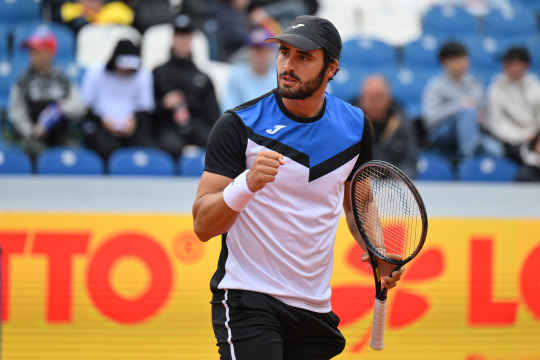#alejandro moro canas
Text
Rome (Italy) Ch F: Alejandro Moro Canas [Alt] def. Vilius Gaubas 7-5, 6-3 Match Stats

📸 ATP official website
Even though the start of the match might have seemed to be a classic Gaubas match with him possibly digging deep, Moro Canas found his range in time thanks to his aggression, where he extended some or most rallies until he stood firm as Gaubas wore down toward the end of the match. This was marked by the prevalence of Gaubas' unforced errors as Moro Canas nailed the most crucial points as he stood firm in the second set. As such, even though both players had 10 break points, Moro Canas converted 50% of them thanks to his physicality that helped carrying his second set performance.
Moreover, Moro Canas had a more solid service game percentage. Serving 4 more aces than Gaubas' 1, Moro Canas won 2% more of his first serve points than Gaubas, which helped him navigate several troubles along the way. Interestingly, the Spanish alternate had an exceptional second serve winning percentage at 61%, even 2% more than his first serves, 22% more than Gaubas, whose second serves became more vulnerable as the match progressed.
This marked Moro Canas' maiden Challenger title to affirm his form, propelling his rank to a career-high of 169 live after winning the title. On the other hand, Gaubas became the number 1 Lithuanian as he entered the Top 300 for the first time, landing at 283 thanks to his runner-up run. Since next week's European Challengers are the 175s, their next Challenger will be in the next two weeks, where Moro Canas will play in Prague 2 and Gaubas became one of the many alternates in the Mauthausen Challenger. Their only ways are up at this rate.
#atp world tour#atp tour#atp challenger#atp challenger tour#tennis updates#match stats#rome (italy) challenger#roma garden open#vilius gaubas#alejandro moro canas#WatchChallengersFolks#ChallengerMatters
0 notes
Text
youtube
#ATP Tour#tennis#Daniel Elahi Galan#Holger Rune#Taylor Fritz#Alejandro Moro Canas#Botic Van de Zandschulp#Jan-Lennard Struff
0 notes
Text
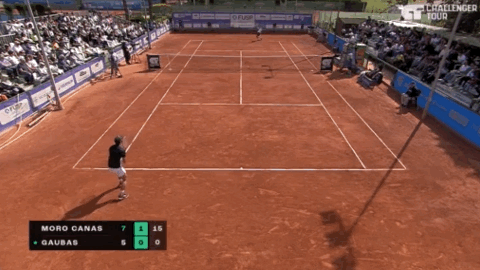
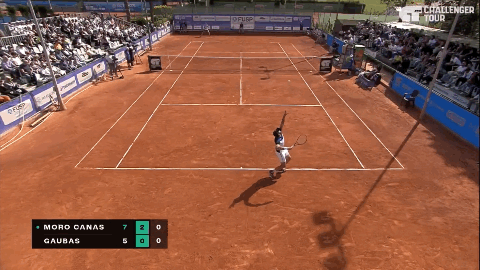
📸 🎥 ATP official website
Moro Canas became firmer starting the second set, as he held his serves to 1-0 before firing a drop shot to set his 2-point lead before breaking early to 2-0 due to a forehand error from Gaubas. Even if the latter had his forehand down-the-line winner to set his lead before having his equal chances, but Moro Canas managed to hold his serves to 3-0.
By then, things became more physical, which became more evident as Gaubas received a medical timeout toward the end of the match, right at the changeover before the penultimate game. The Spanish alternate stayed consistent until the end of the match, where he successfully served it out (and held to 0) to secure the championship, taking the second set 6-3 to finally win his maiden Challenger title.
#atp world tour#atp tour#atp challenger#atp challenger tour#tennis updates#hot shots#match point#rome (italy) challenger#roma garden open#alejandro moro canas#vilius gaubas#WatchChallengersFolks#ChallengerMatters
0 notes
Text


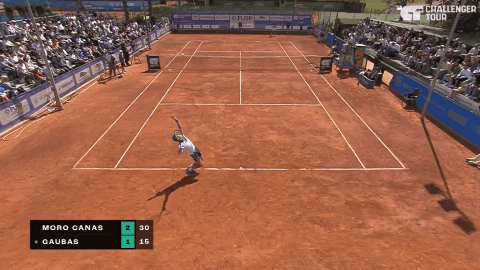

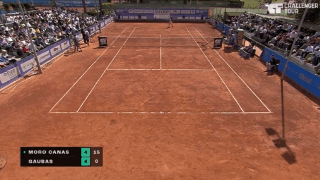
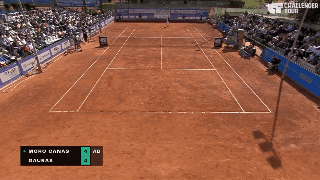


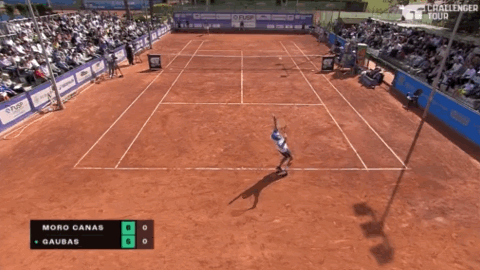


📸 ATP official website
The next Challenger-level finals for the day came from the Rome (Italy) Challenger, as both finalists sought for their maiden Challenger-level title. Alternate Alejandro Moro Canas, who stunned first seed Zsombor Piros 6-4, 6-3 in the first round and went on defeating defending runner-up and fifth seed Jesper de Jong 7-6(1), 6-4 in the quarterfinals and Stefano Travaglia 6-3, 6-7(4), 6-2 in the semifinals after undergoing a scenic route, faced another talented youngster in Vilius Gaubas, who remarkably edged out second seed Nicolas Moreno de Alboran 6-3, 6-4 in the quarterfinals and eighth seed Hugo Dellien 6-4, 7-5 after being one break down in each set to close yesterday's semifinals. As this match tested their return depth and aggression to some extent, it all came down to physicality as one got firmer toward the end of the match.
The match started in the most topsy-turvy way possible (in a similar manner to Gaubas' semifinal match) as Moro Canas initially had a solid start through his backhand pass to set up one of his earlier leads before breaking early to 2-0, where Gaubas ended up breaking back (2-1) thanks to his backhand pass, which turned out was the key of the last few points to secure the said break. However, the moment did not last long as Moro Canas broke back again (3-1) due to Gaubas' forehand error, which became prevalent in the said game.
Subsequently, the Spaniard held his service game (4-1) and Gaubas followed suit before the latter started digging deep again as his down-the-line finishes kicked off the next game before breaking back to 4-3, levelling the play afterward with a service game hold to 4-4. Gaubas became slightly more aggressive since then, firing a forehand down-the-line winner to secure a crucial equalizer before foiling Moro Canas' earlier game points almost similarly, somehow forced another deuce through a powerful forehand winner several points prior to the break of serve thanks to his backhand pass to conclude a rally (5-4). By then, Gaubas earned his chance to serve for the first set, where he fumbled due to his forehand errors (5-5).
Moro Canas then held his serves to 6-5, and asked the necessary questions regarding the possibility of a tie-break. He fired a backhand down-the-line winner to start the twelfth game, where his redirections ended up resulting in Gaubas' frequent errors, generating the former's set points as a result. Even though the unseeded Lithuanian foiled one of the said set points through a forehand pass, it was insufficient as Moro Canas turned out to break for the set (7-5) due to the former's forehad mishit, which was fired too long, putting himself one set away, technically, from the title.
#atp world tour#atp tour#atp challenger#atp challenger tour#tennis updates#hot shots#break point#set point#rome (italy) challenger#roma garden open#alejandro moro canas#vilius gaubas#WatchChallengersFolks#ChallengerMatters
1 note
·
View note
Text
youtube
0 notes
Text
youtube
0 notes
Text
youtube
0 notes
Text
Valencia Ch QF: Roberto Bautista Agut [1] def. Alejandro Moro Canas [LL] 6-2, 7-5 Match Stats
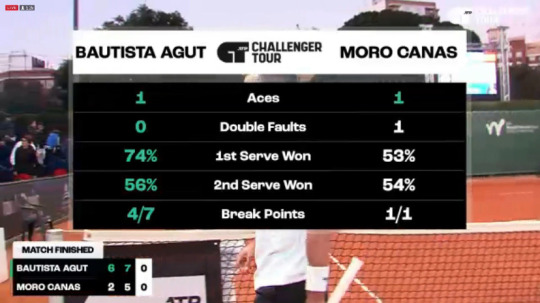
📸 ATP Challenger Livestream
Bautista Agut controlled most of the flow from the baseline, bringing Moro Canas off the balance thanks to his important winners. However, Moro Canas tried to step up, which resulted in Bautista Agut’s only time when he got broken (thus the former’s 100% break point conversion rate), to no avail as Bautista Agut re-absorbed the pace and appeared more aggressive, using his experience to deny Moro Canas the second set tie-breaker, with a down-the-line winner to start it all. As a result, Bautista Agut had 7 opportunities to break, converting 4 of them across both sets.
On the other hand, Bautista Agut stood out from his first serves with a 74% winning percentage than Moro Canas’ 53%, making the latter’s first serve more vulnerable since he also had a 1% lesser winning percentage compared to his second serve. Despite Moro Canas just double-faulted once, Bautista Agut had a slight edge from his second serve by 2%, winning 56% points from his second serve than Moro Canas’ 54%. This denoted Bautista Agut’s slightly outstanding service game despite the beginning of the second set’s mess through his follow-up forehands, but he managed to get the situation under control since.
A classic semifinal match-up will happen as Bautista Agut will face qualifier Denis Yevseyev, who defeated wild card Martin Landaluce 7-6(6), 7-6(2) in a chaotic, but close encounter that boiled down to the tie-breakers despite both players’ slight edges. Knowing both players, this could be interesting to see how both players held up in point construction department, with their balance becoming the most important and tested element in the match. This could put an interesting showing for the day, highly recommended for its entertainment (other than the other semifinal match)!
#atp world tour#atp tour#atp challenger#atp challenger tour#tennis updates#match stats#valencia challenger#copa faulcombridge#roberto bautista agut#alejandro moro canas#WatchChallengersFolks#ChallengerMatters
0 notes
Text
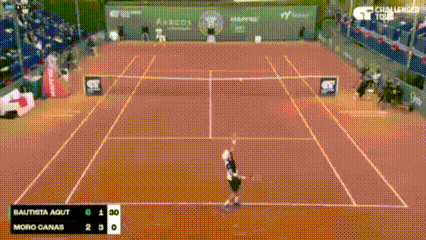

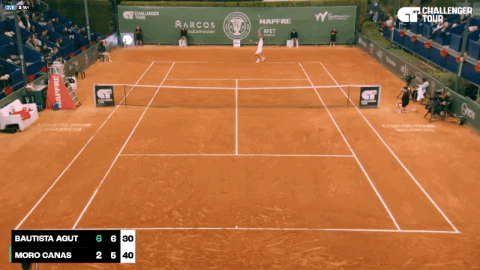
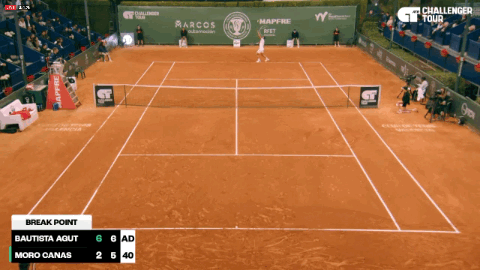
📸 🎥 ATP Challenger Livestream
However, Bautista Agut had an erratic start to the second set, with his shot errors (mostly backhand, and then forehand) resulted in Moro Canas’ early break to 1-0. Moro Canas followed it with a service game hold to 2-0, but it took two consecutive holds before Bautista Agut had a notable volley winner in a volley-to-volley exchange to create his game point, surviving several deuces (and game points’ foiling) before he held his service game to 2-3. It turned out to be an important hold due to Moro Canas’ subsequent erratic service game, followed by an important backhand down-the-line approach, where Moro Canas’ forehand got outhit for his break point before another forehand error resulted in Bautista Agut’s break-back to 3-3. As a result, Bautista Agut leveled the play and held his service game to 4-3 as a result of his play-levelling.
Four service game holds later, Moro Canas had an opportunity to serve to force the second set tie-break. However, Bautista Agut started to have more ideas, with a backhand down-the-line winner securing the important first deuce of the game before Moro Canas’ error set up his first match point, which was foiled thanks to Moro Canas’ working volley. However, Moro Canas had to face another match point, which was converted immediately thanks to Bautista Agut’s backhands, which aimed at Moro Canas’ forehands until the latter had one of those shots netted, taking the second set 7-5 as well as securing his path to the semifinals as a result.
#atp world tour#atp tour#atp challenger#atp challenger tour#tennis updates#hot shots#break point#match point#valencia challenger#copa faulcombridge#roberto bautista agut#alejandro moro canas#WatchChallengersFolks#ChallengerMatters
0 notes
Text
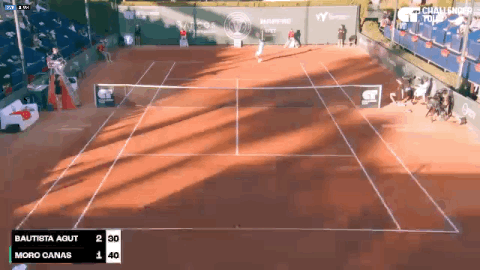

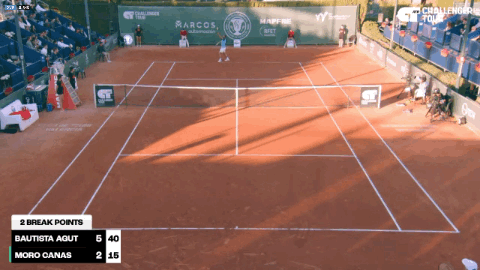
📸 ATP Challenger Livestream
Reaching his first Challenger quarterfinal since 2013, first seed Roberto Bautista Agut defeated Andrea Vavassori 6-3, 6-4 and Andrea Pellegrino 7-5, 6-3 in the first two rounds, where he faced lucky loser Alejandro Moro Canas, who previously stunned Sumit Nagal 6-4, 6-3 in the first round and Rudolf Molleker 6-4, 6-4 in the second round. Knowing both players, the margin could be thin depending on which version of both players were on when it comes to constructing their points in general.
However, Bautista Agut seemed to be more in control in the first set, dominating the flow from the baseline when the moments kicked in. He started it with a working volley, but Moro Canas failed to reach the ball in time for the ball to be declared in first before he even responded, causing the important deuce before Moro Canas’ subsequent forehand errors resulted in the break of serve to 3-1. Bautista Agut then followed it with a consolidation to 4-1.
Two consecutive holds later, Bautista Agut started to press Moro Canas more from the baseline, coming up with a working volley in response to Moro Canas’ drop shot to set up his set point after Moro Canas’ other unforced error before Moro Canas’ backhand error in response to Bautista Agut’s preceding volley allowed the first seed to take the first set 6-2, which set him one set ahead to the semifinals.
#atp world tour#atp tour#atp challenger#atp challenger tour#tennis updates#hot shots#break point#set point#valencia challenger#copa faulcombridge#roberto bautista agut#alejandro moro canas#WatchChallengersFolks#ChallengerMatters
0 notes
Text
Ortisei Ch D R1: Daniel Cukierman/Joshua Paris [2] def. David Jorda Sanchis/Alejandro Moro Canas 6-4, 7-5 Match Stats
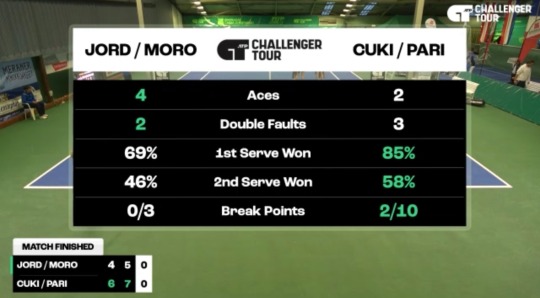
📸 ATP Challenger Livestream (via website)
Cukierman/J. Paris were more proactive in their return games, already setting up points from the net to put more pressure on Jorda Sanchis/Moro Canas’ serves. Thanks to their working volleys, Jorda Sanchis/Moro Canas missed their extra shots, some of which were attempted lobs where they tried to make Cukierman/J. Paris stay back. As a result, Cukierman/J. Paris nailed their important points, creating 10 opportunities to break along the way, even if they only converted 20% of them throughout both sets in opposed to Jorda Sanchis/Moro Canas’ 0 conversions out of 3 deciding points on Cukierman/J. Paris’ serves.
Service game-wise, Cukierman/J. Paris appeared more consistent, despite the risks taken. Jorda Sanchis/Moro Canas might have scored twice more aces than Cukierman/J. Paris (4 to 2), but the latter stood out in the points won from their first serves with a 85% percentage, winning 16% more thanks to their clutchness under pressure (including the decisive deciding points). On the other hand, Cukierman/J. Paris might have risked their second serves with 3 double faults to Jorda Sanchis/Moro Canas’ 2, but the former still won 8% more points through their second serves thanks to their working point construction follow-ups.
However, it was found out that Denis Istomin/Evgeniy Karlovskiy withdrew right before their scheduled quarterfinals match tomorrow (which was Cukierman/J. Paris’ third Chalenger quarterfinals appearance as a pair), leaving Cukierman/J. Paris to advance to their second semifinals together. Jumping through the semifinals, they will face the winner between Elliot Benchetrit/Louis Wessels or Maximilian Neuchrist/Jakub Paul. While this could be a potentially tough match, the net game could also factor in their point construction and rallies, where balance could also be another important element. This could be a fun semifinal match!
#atp world tour#atp tour#atp challenger#atp challenger tour#tennis updates#match stats#ortisei challenger#sparkasse challenger val gardena#david jorda sanchis#alejandro moro canas#daniel cukierman#joshua paris#WatchChallengersFolks#ChallengerMatters#WatchMoreDOUBLES
0 notes
Text
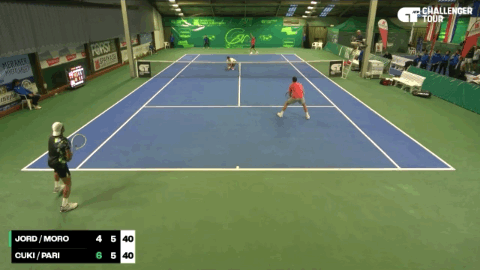
📸 🎥 ATP Challenger Livestream (via website)
The second set was almost a service game-oriented one, and Jorda Sanchis/Moro Canas saved several break points and still held several service games along the way. However, the net game once again became their biggest adversary once Cukierman/J. Paris dialed in there, with Cukierman’s volleys not only opening the path for the break, but also allowed them to break right on deciding point (6-5). As a result, the second seeds had an opportunity to serve for the match, where they eventually did: serving an ace to secure their match point, and converting it thanks to their working serve+1 (ended with J. Paris’ forehand, but Jorda Sanchis/Moro Canas’ extra shot went too wide), which resulted in them advancing to the quarterfinals, taking the second set 7-5.
#atp world tour#atp tour#atp challenger#atp challenger tour#tennis updates#hot shots#break point#match point#ortisei challenger#sparkasse challenger val gardena#david jorda sanchis#alejandro moro canas#daniel cukierman#joshua paris#WatchChallengersFolks#ChallengerMatters#WatchMoreDOUBLES
0 notes
Text
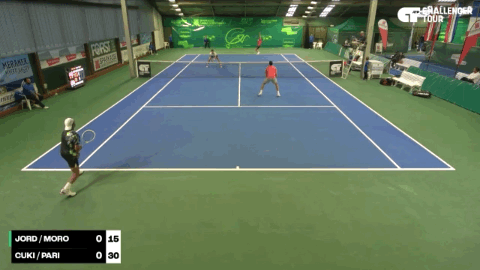

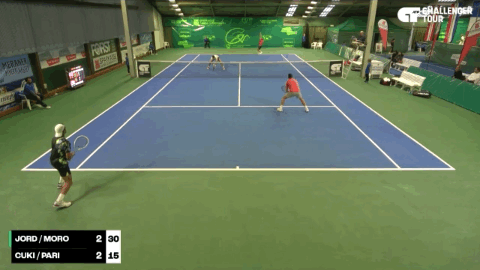

📸 ATP Challenger Livestream (via website)
The doubles action continued in the Ortisei Challenger with the second seeds Daniel Cukierman/Joshua Paris taking on David Jorda Sanchis/Alejandro Moro Canas in the first round. Knowing both pairs, this could be an interesting match to see where things were on, but the net game became one of the most important determinants in this match. Here was how things unfolded in the first set.
Initially, Cukierman/J. Paris had an interesting start from J. Paris’ working volley to secure their initial break points before Jorda Sanchis/Moro Canas saved them also with a working volley, forcing a deciding point until the latter held their service games to 1-0. It took three other consecutive holds before Cukierman’s volley (before a lob that went too far) opened up the path for an important equalizer, and his swift forehand returns right to force and on the deciding point resulted in their important break to 3-2.
Cukierman/J. Paris followed up their lead with a strong hold to 4-2 despite having to face a deciding point later on, and they had not looked back since. After the other consecutive holds, the second seeds had an opportunity to serve for the first set. Despite a stiff opposition from Jorda Sanchis/Moro Canas, who saved one of the set points with a working volley, Cukierman/J. Paris served it out with an ace to take the first set 6-4.
#atp world tour#atp tour#atp challenger#atp challenger tour#tennis updates#hot shots#break point#set point#ortisei challenger#sparkasse challenger val gardena#david jorda sanchis#alejandro moro canas#daniel cukierman#joshua paris#WatchChallengersFolks#ChallengerMatters#WatchMoreDOUBLES
0 notes
Text
Prague 2 Ch SF: Jakub Mensik [WC] def. Alejandro Moro Canas [Alt] 6-2, 7-5 Match Stats
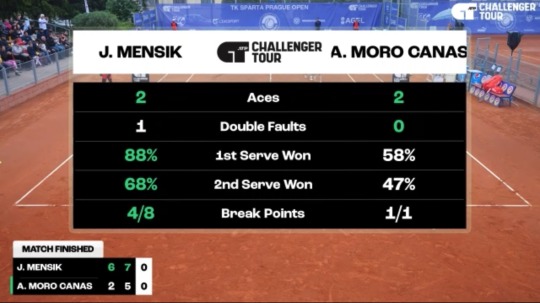
📸 ATP Challenger Livestream (via website)
This is surely a home run in the making for J. Mensik. Not only he controlled the flow since the start (bar the second set hiccup), but he also pressed Moro Canas until the net game became the question in one way or another.
Although both J. Mensik and Moro Canas produced 2 aces each until the end of the match, J. Mensik’s first serves efficacy stood out by winning overwhelmingly 30% more of his points from there compared to Moro Canas. Interestingly, although J. Mensik just double-faulted once, the second serves remained the most vulnerable aspect for Moro Canas since he could only win 47% of his points from there.
The only occasion where J. Mensik got broken, hence Moro Canas’ 100% break point conversion rate, came from an erratic service game to start the second set. However, J. Mensik’s aggression, thanks to his baseline control from his shots, paid off since he got 8 opportunities to break. Most of his conversions came from the way he brought Moro Canas forward, with the latter having more questionable net games (with failed drop shots or volleys, for example), but 50% of them got converted until the end of the match, signifying his ability to maximize his chances.
In the finals, J. Mensik will face either sixth seed Dominik Koepfer or Nicolas Kicker, which match is still ongoing. While Koepfer also built his form back in the Mexican Challengers (some clay ones from two-three months back), Kicker tried to regain his form in the clay season after one setback and another. This could be an interesting battle of generations, but the action is worth following!
#atp world tour#atp tour#atp challenger#atp challenger tour#tennis updates#match stats#prague 2 challenger#tk sparta prague open#jakub mensik#alejandro moro canas#WatchChallengersFolks#ChallengerMatters
0 notes
Text


📸 🎥 ATP Challenger Livestream (via website)
Moro Canas tried to raise his level in the second set, but J. Mensik’s depth allowed him to find a way out. He was initially 1-4 down because of some erratic reason, but he found the key to break back to 3-4 thanks to his smash that opened a way to break as one of his break points.
Furthermore, J. Mensik always came up with something, with a forehand to 5-5* 0-30 opened the path to give more pressure to Moro Canas from the baseline. Indeed, that resulted in Moro Canas’ forehand error, before J. Mensik broke 2 points later at the expense of Moro Canas’ forehand error. Controlling the flow from his forehand at the baseline, J. Mensik then had the opportunity to serve for the match.
Although one of his match points were saved because of Moro Canas’ cross-court forehand winner (to *6-5 40-15), J. Mensik’s backhand winner successfully got him the second set (7-5), eventually making it to his first ever Challenger final to continue his home run.
#atp world tour#atp tour#atp challenger#atp challenger tour#tennis updates#hot shots#break point#set point#prague 2 challenger#tk sparta prague open#jakub mensik#alejandro moro canas#WatchChallengersFolks#ChallengerMatters
0 notes
